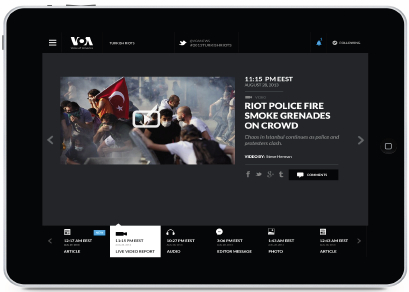With Relay, a new platform for live blogging in all its forms, Randy Abramson hopes he has solved a problem for news organizations in need of a central, well-designed hub for multimedia in breaking-news situations.
Abramson is director of audio/video for the Broadcasting Board of Governors, which oversees Voice of America, Radio Free Europe and other U.S. government-backed broadcasting organizations. His background includes stints at Newsweek.com and the Star-Ledger.
 In his current, more strategic role, Abramson has been able to step back and evaluate how news organizations overall cover breaking news. He said coverage of the Boston Marathon bombings and the Washington Navy Yard shootings convinced him that news organizations are well-prepared for news gathering in terms of staffing levels and reporting tools. But the trouble, he said, is that the presentation is so often lacking, especially on tablets and smartphones.
In his current, more strategic role, Abramson has been able to step back and evaluate how news organizations overall cover breaking news. He said coverage of the Boston Marathon bombings and the Washington Navy Yard shootings convinced him that news organizations are well-prepared for news gathering in terms of staffing levels and reporting tools. But the trouble, he said, is that the presentation is so often lacking, especially on tablets and smartphones.
As it stands, tools such as CoveritLive and ScribbleLive are used primarily for text-based updates, including tweets. They’re also often very difficult to view on a mobile device, particularly when embedded in a story.
Relay is designed with tablets first in mind, Abramson said. Although smartphones are more ubiquitous than tablets, the nature of the content presented via Relay — video and photos, primarily — means tablets are a more natural fit. Each element is presented in a story-card format, easily and naturally browsable with a swipe of a finger. Abramson cited Apple’s iPhoto app as inspiration for the rhythm he wants users to feel as they swipe through content.

- Relay was used in Urdu VOA’s coverage of Nelson Mandela’s death, shown here on a Nexus 7 tablet.
Relay isn’t just intended to be a more friendly live blogging experience for users on the front end; it’s also intended to be a friendly experience for content creators on the back end, with support for posting text and photos via email. Authorized blog contributors — e.g. reporters in the field or social media editors back in the office — can post swiftly through a wide variety of media.
“As we were thinking this through, we wanted to create a tool that accepts content from all sources,” Abramson said. That means YouTube and Vimeo videos, Flickr photos, Livestream feeds, SoundCloud audio clips, and tweets all work on the platform.
Still, an advantage of embeddable, primarily text-based liveblogging tools is that they live on a news organization’s site itself — no small consideration for publishers trying to monetize online audiences.
The web app is intended to function as smoothly as users expect from native apps, so Abramson wasn’t sure embedding the Relay experience into existing web pages would be possible or worth sacrificing the full experience. But he said he was open to working with news partners in customizing the format for their needs, possibly on separate domains.
In that spirit of openness, Relay’s an open project on Github, and Abramson hopes news organizations and schools will dig into the platform and take advantage of its storytelling possibilities.







Comments